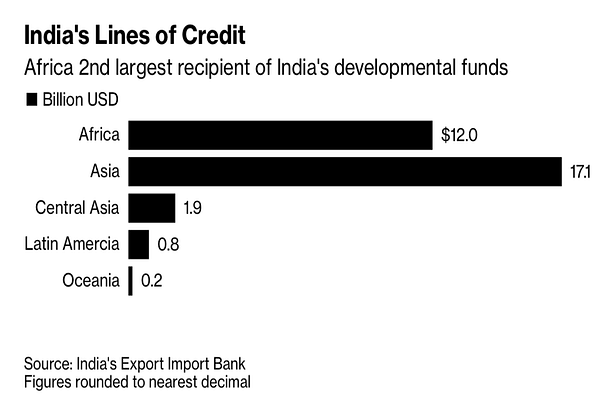
Contrasting Approaches: While China focuses on resource extraction and strategic leverage through “debt-trap diplomacy,” India emphasizes humanitarian needs, sustainable development, and mutual trust in Africa.
Strategic Interests: China targets eastern Africa for proximity to the Suez Canal, while India fosters relationships with African nations influential in the Indo-Pacific and multilateral forums like BRICS.
Geopolitical Alignment: India positions itself as a Global South leader, leveraging shared values and historical ties with African nations.
Growing Engagement: India has significantly expanded its African diplomatic presence, with 18 new consulates and increased credit lines in the last decade
Africa, a continent rich in resources and boasting a youthful demographic, has emerged as a focal point in 21st-century geopolitics. The U.S., China, and India are all vying for influence across the continent, but their investment strategies differ significantly. Notably, the approaches of India and China contrast sharply in terms of purpose and impact.
China’s primary interest in Africa lies in its abundant raw materials, which it seeks to access while fostering a strategic presence on the continent. Rather than prioritizing African development, China’s approach often focuses on securing resources. This has led to the adoption of what’s commonly referred to as “debt-trap diplomacy.” China provides substantial loans, sometimes amounting to billions of dollars, to African countries. These loans often prove difficult for the recipient nations to repay, resulting in China securing various forms of leverage—ranging from increased control over infrastructure projects to stakes in government-run mining companies.
African nations, eager for development but lacking sufficient financial resources, sometimes accept these Chinese investments despite the conditions attached. A notable example is Kenya, where China has made significant investments due to the country’s rich reserves of rare earth minerals. However, the heavy debt burden has often rendered these countries unable to repay China, which, in turn, expands China’s influence through infrastructure and mining sectors.

China’s focus on the eastern coast of Africa also serves a strategic purpose. By investing heavily in coastal countries in this region, China aims to enhance its visibility and reach toward the Suez Canal and the broader Indo-Pacific region.
India’s engagement in Africa has taken a different approach compared to China. India has not only focused on building infrastructure and gaining access to resources but has also prioritized addressing humanitarian needs. This approach has made India a welcomed partner in many African nations. Recently, India has significantly increased its lending to African countries, positioning itself as a trustworthy partner.
India views this lending as an opportunity to convey a message to African nations: Africa should not become a geopolitical battleground for competing powers like China and Western alliances. Instead, investments in Africa should serve the continent’s population and foster sustainable development. While India competes with China in infrastructure development, it emphasizes building mutual trust and ensuring that both parties benefit from their collaboration. By addressing humanitarian needs and fostering partnerships, India can strengthen its strategic foothold in Africa.

One strategic advantage for India lies in engaging with African nations that have influence in critical geopolitical areas, such as the Indo-Pacific region. For instance, regions like Somaliland, which recently declared itself independent from Somalia, offer opportunities for collaboration. Somaliland’s strategic location near key maritime routes makes it an important area for geopolitical influence. With ongoing disputes in Northeast Africa—such as tensions involving Egypt, Somalia, Ethiopia, and Turkey—India could leverage its position to access vital ports and strengthen its ties in the region.
Moreover, India’s longstanding commonalities with African nations serve as a foundation for deeper engagement. All African countries, like India, are part of the Global South, and India has recently emerged as a prominent voice for these nations. Furthermore, countries such as Egypt and South Africa are key allies in multilateral forums like BRICS, creating additional avenues for collaboration.
Indian External Affairs Minister S Jaishankar has explained India’s strategy for aiding Africa by saying, “We are trying to think 25 years from now, asking ourselves where are we likely to be in 2047 and what should we be doing now to prepare for it.” 18 of the 25 new consulates that have opened in the last nine years have been in Africa, according to the Bloomberg report.
Africa’s current status as the second-largest beneficiary of Indian credit shows how important the region is becoming to India’s strategic goals.
References:
- https://swarajyamag.com/foreign-affairs/india-counters-chinas-growing-influence-in-africa-with-12-billion-in-credit-to-42-countries
- https://www.bloomberg.com/news/articles/2023-07-05/india-increases-africa-lending-in-the-race-to-counter-china?utm_medium=social&cmpid%3D=socialflow-twitter-politics&utm_content=politics&utm_source=twitter&utm_campaign=socialflow-organic
Satish Chogule is pursuing a Masters in Political Science at the University of Kolhapur, Maharashtra. He has contributed to several online platforms on international affairs and global developments. Views expressed are the author’s own.
